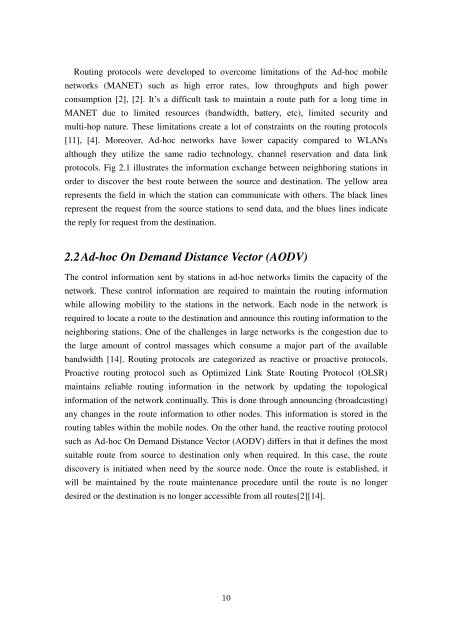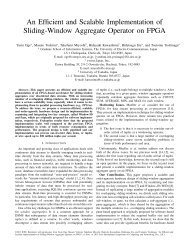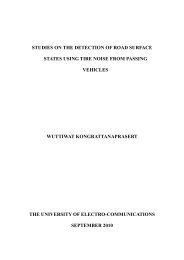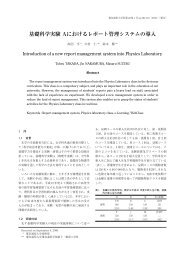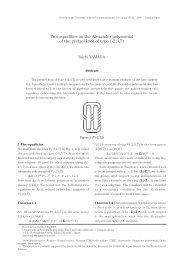a study on the spectrum efficient multi-hop wireless network
a study on the spectrum efficient multi-hop wireless network
a study on the spectrum efficient multi-hop wireless network
Create successful ePaper yourself
Turn your PDF publications into a flip-book with our unique Google optimized e-Paper software.
Routing protocols were developed to overcome limitati<strong>on</strong>s of <strong>the</strong> Ad-hoc mobile<br />
<strong>network</strong>s (MANET) such as high error rates, low throughputs and high power<br />
c<strong>on</strong>sumpti<strong>on</strong> [2], [2]. It’s a difficult task to maintain a route path for a l<strong>on</strong>g time in<br />
MANET due to limited resources (bandwidth, battery, etc), limited security and<br />
<strong>multi</strong>-<strong>hop</strong> nature. These limitati<strong>on</strong>s create a lot of c<strong>on</strong>straints <strong>on</strong> <strong>the</strong> routing protocols<br />
[11], [4]. Moreover, Ad-hoc <strong>network</strong>s have lower capacity compared to WLANs<br />
although <strong>the</strong>y utilize <strong>the</strong> same radio technology, channel reservati<strong>on</strong> and data link<br />
protocols. Fig 2.1 illustrates <strong>the</strong> informati<strong>on</strong> exchange between neighboring stati<strong>on</strong>s in<br />
order to discover <strong>the</strong> best route between <strong>the</strong> source and destinati<strong>on</strong>. The yellow area<br />
represents <strong>the</strong> field in which <strong>the</strong> stati<strong>on</strong> can communicate with o<strong>the</strong>rs. The black lines<br />
represent <strong>the</strong> request from <strong>the</strong> source stati<strong>on</strong>s to send data, and <strong>the</strong> blues lines indicate<br />
<strong>the</strong> reply for request from <strong>the</strong> destinati<strong>on</strong>.<br />
2.2 Ad-hoc On Demand Distance Vector (AODV)<br />
The c<strong>on</strong>trol informati<strong>on</strong> sent by stati<strong>on</strong>s in ad-hoc <strong>network</strong>s limits <strong>the</strong> capacity of <strong>the</strong><br />
<strong>network</strong>. These c<strong>on</strong>trol informati<strong>on</strong> are required to maintain <strong>the</strong> routing informati<strong>on</strong><br />
while allowing mobility to <strong>the</strong> stati<strong>on</strong>s in <strong>the</strong> <strong>network</strong>. Each node in <strong>the</strong> <strong>network</strong> is<br />
required to locate a route to <strong>the</strong> destinati<strong>on</strong> and announce this routing informati<strong>on</strong> to <strong>the</strong><br />
neighboring stati<strong>on</strong>s. One of <strong>the</strong> challenges in large <strong>network</strong>s is <strong>the</strong> c<strong>on</strong>gesti<strong>on</strong> due to<br />
<strong>the</strong> large amount of c<strong>on</strong>trol massages which c<strong>on</strong>sume a major part of <strong>the</strong> available<br />
bandwidth [14]. Routing protocols are categorized as reactive or proactive protocols.<br />
Proactive routing protocol such as Optimized Link State Routing Protocol (OLSR)<br />
maintains reliable routing informati<strong>on</strong> in <strong>the</strong> <strong>network</strong> by updating <strong>the</strong> topological<br />
informati<strong>on</strong> of <strong>the</strong> <strong>network</strong> c<strong>on</strong>tinually. This is d<strong>on</strong>e through announcing (broadcasting)<br />
any changes in <strong>the</strong> route informati<strong>on</strong> to o<strong>the</strong>r nodes. This informati<strong>on</strong> is stored in <strong>the</strong><br />
routing tables within <strong>the</strong> mobile nodes. On <strong>the</strong> o<strong>the</strong>r hand, <strong>the</strong> reactive routing protocol<br />
such as Ad-hoc On Demand Distance Vector (AODV) differs in that it defines <strong>the</strong> most<br />
suitable route from source to destinati<strong>on</strong> <strong>on</strong>ly when required. In this case, <strong>the</strong> route<br />
discovery is initiated when need by <strong>the</strong> source node. Once <strong>the</strong> route is established, it<br />
will be maintained by <strong>the</strong> route maintenance procedure until <strong>the</strong> route is no l<strong>on</strong>ger<br />
desired or <strong>the</strong> destinati<strong>on</strong> is no l<strong>on</strong>ger accessible from all routes[2][14].<br />
10


